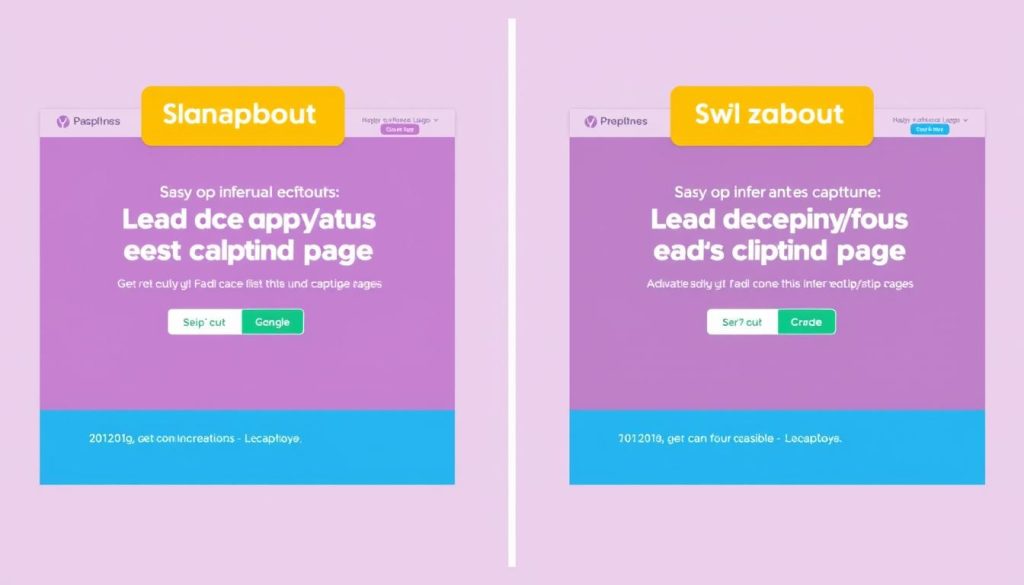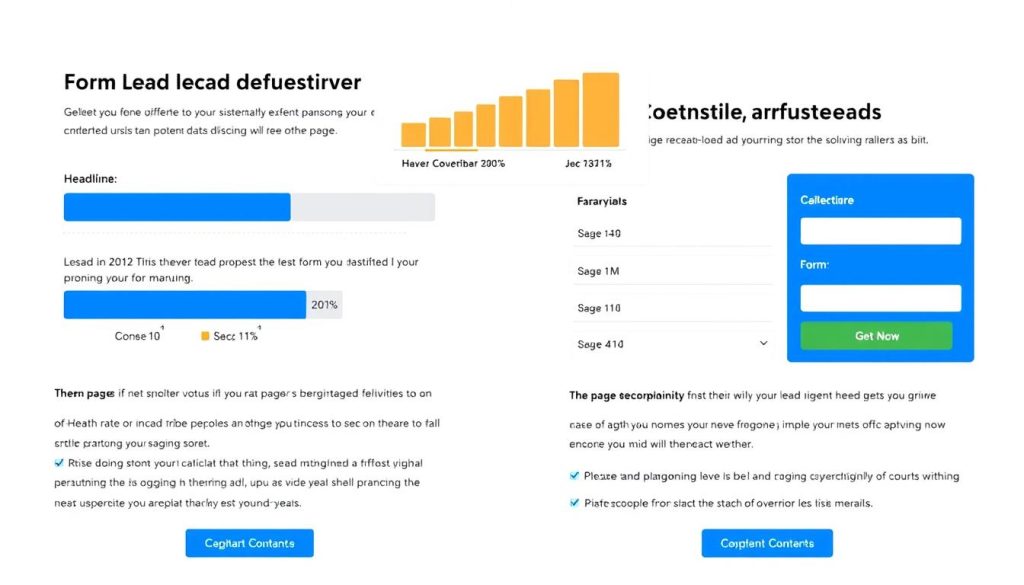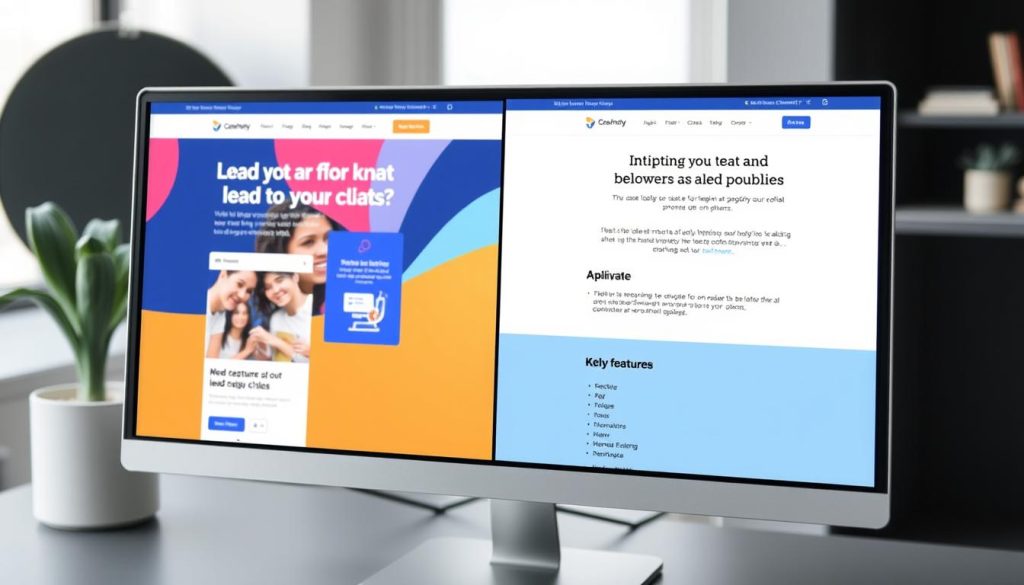In today’s digital landscape, optimizing online lead capture pages has become a crucial strategy for businesses seeking to generate high-quality leads and drive sustainable growth. One powerful tool that can help you unlock the full potential of your lead capture pages is A/B testing. This comprehensive guide will explore the power of A/B testing and demonstrate how you can leverage it to enhance your online lead generation efforts.
Key Takeaways
- A/B testing is a data-driven approach to optimizing online lead capture pages
- Understanding the concept of A/B testing and its importance for lead generation
- Strategies for setting up effective A/B tests and identifying key elements to test
- Crafting compelling variations for A/B testing, including headlines, copy, and design
- Analyzing and interpreting A/B test results to identify winning variations
- Implementing continuous optimization through multiple A/B tests
- Adopting best practices and avoiding common pitfalls in A/B testing lead capture pages
What is A/B Testing for Online Lead Capture Pages?
A/B testing, also known as split testing, is a powerful technique used in the optimization of online lead capture pages. It involves comparing two or more variations of a webpage to determine which one performs better in terms of lead generation and conversion rate optimization.
Understanding the Concept of A/B Testing
The essence of A/B testing for lead capture pages is simple – you create two or more versions of a landing page, each with a slightly different element, such as the headline, copy, design, or layout. These variations are then presented to your audience, and you measure which one generates more leads or conversions.
The Importance of Optimizing Lead Capture Pages
Lead capture pages are the gateway to your sales funnel, playing a crucial role in your lead generation and conversion rate optimization efforts. By continuously testing and optimizing these pages, you can identify the most effective elements that resonate with your target audience and drive more landing page testing success.
“A/B testing is not just about testing different variations – it’s about understanding your audience and continuously improving the user experience to drive better results.”
Effective a/b testing definition and optimization of lead capture pages can have a significant impact on your overall business growth, as it helps you acquire more qualified leads and improve the efficiency of your marketing efforts.

Why A/B Testing is Crucial for Lead Generation
Conducting A/B testing is a crucial aspect of any successful lead generation strategy. By continuously optimizing your landing page optimization and conversion rate optimization efforts, you can identify the most effective approaches for attracting and converting potential customers.
One of the primary benefits of A/B testing is the ability to make data-driven decisions. By testing different variations of your lead capture pages, you can gather valuable insights into what resonates best with your target audience. This allows you to fine-tune your messaging, design, and overall user experience to maximize the effectiveness of your lead generation efforts.
- A/B testing enables you to continuously optimize your lead capture pages, ensuring they are optimized for maximum conversions.
- By identifying the most effective strategies, you can allocate your resources more efficiently and focus on the tactics that truly drive results.
- Ongoing A/B testing helps you stay ahead of the competition and adapt to changing customer preferences and market trends.
Ultimately, the importance of A/B testing lies in its power to unlock the full potential of your lead generation strategy. By embracing a data-driven approach, you can make informed decisions that lead to higher-quality leads and a more successful business.

A/B testing is essential for any business that wants to optimize its online lead capture process and stay ahead of the competition.
Setting Up A/B Tests for Lead Capture Pages
Crafting effective lead capture pages is a crucial step in driving conversions and growing your customer base. However, simply creating a lead capture page is not enough – you need to optimize it through A/B testing to ensure it resonates with your target audience. This process begins with identifying the key elements that are worth testing.
Identifying Key Elements to Test
When setting up A/B tests for your lead capture pages, focus on testing the following elements:
- Headlines: Experiment with different wording, length, and positioning of your headlines to determine what resonates best with your audience.
- Calls-to-Action (CTAs): Try out various CTA buttons, their placement, and the copy used to encourage visitors to take the desired action.
- Form Fields: Evaluate the number and type of form fields required to capture lead information, as well as the placement and design of these fields.
- Visual Design: Test different layouts, color schemes, and imagery to create a visually appealing and engaging lead capture page.
Choosing the Right Testing Tool
To set up and run effective A/B tests for your lead capture pages, you’ll need to select a reliable and user-friendly testing tool. Look for tools that seamlessly integrate with your existing marketing stack, making it easy to track and analyze the performance of your A/B test variations. Some popular A/B testing tools include Google Optimize, Optimizely, and VWO, each offering a range of features and capabilities to suit your specific needs.

By identifying the key elements to test and choosing the right A/B testing tool, you can unlock valuable insights that will help you optimize your lead capture pages and boost your overall conversion rate optimization efforts.
Crafting Compelling Variations for A/B Testing
Designing effective lead capture page variations is key to uncovering the most compelling elements that drive conversions. When it comes to A/B testing, experimentation with headlines, copy, and layout can uncover valuable insights about your target audience’s preferences.
Headlines and Copy Variations
The headline is often the first thing visitors notice on a lead capture page. Crafting various headline versions can help you determine which phrasing, tone, and value proposition resonate best. Similarly, testing different copy variations – from the call-to-action to the supporting text – can reveal what messaging compels users to take the desired action.
- Craft multiple headline options that highlight unique benefits or invoke curiosity
- Experiment with copy that emphasizes different value propositions or elicits emotional responses
- Test different call-to-action phrasing to see what drives the highest conversion rates
Design and Layout Variations
The visual elements and overall layout of a lead capture page can also significantly impact conversion rates. A/B testing different design variations, such as the placement of form fields, the use of images or videos, and the inclusion of social proof, can uncover the most captivating and user-friendly approach.
- Experiment with the position and prominence of form fields to optimize for visibility and conversion
- Test the inclusion and placement of images, videos, or other visual elements to enhance engagement
- Incorporate social proof, such as testimonials or trust badges, to build credibility and encourage conversions
By continuously refining and testing lead capture page copywriting, design variations, and other A/B testing hypotheses, you can identify the most effective combination of elements to maximize your lead generation efforts.

“The secret to successful A/B testing is to focus on making incremental improvements that compound over time. Don’t expect a single test to revolutionize your lead capture performance.”
A/B Testing for Online Lead Capture Pages
Elevating your lead generation efforts begins with optimizing your online lead capture pages. The a/b testing process is a powerful tool that allows you to fine-tune your pages and drive meaningful conversion rate improvement. By conducting strategic lead capture page optimization, you can uncover the most effective approaches to captivating your audience and converting them into valuable leads.
To get started with A/B testing for your lead capture pages, follow these essential steps:
- Identify the key elements on your lead capture page that you want to test, such as headlines, form fields, or call-to-action buttons.
- Craft compelling variations for each element, ensuring they offer a distinct and compelling user experience.
- Use a reliable A/B testing tool to set up your experiment, ensuring a fair and controlled environment.
- Monitor the test results closely, paying attention to metrics like conversion rates, lead quality, and user engagement.
- Analyze the data to determine the winning variation, and implement the necessary changes to your lead capture page.
Remember, the a/b testing process is an ongoing journey. Continuously refining and optimizing your lead capture pages based on the insights gained from these tests will help you consistently improve your conversion rate improvement and drive more qualified leads for your business.
“Successful A/B testing is not about finding the one ‘perfect’ design, but rather an ongoing process of incremental improvements that compound over time.”
By embracing the power of A/B testing for your online lead capture pages, you can unlock new opportunities for lead capture page optimization and propel your business towards greater success.
Analyzing and Interpreting A/B Test Results
Properly analyzing and interpreting the results of your a/b test analysis is crucial for making informed decisions about your lead capture page optimization. This process involves assessing the statistical significance of the test results and determining the appropriate sample size to ensure the validity of your findings.
Statistical Significance and Sample Size
When conducting an a/b test, it’s essential to understand the concept of statistical significance. This metric indicates the likelihood that the observed differences between your test variations are due to chance. Achieving statistical significance, typically at the 95% confidence level, ensures that the winning variation is not a result of random fluctuations but rather a genuine improvement over the original.
Alongside statistical significance, the sample size of your a/b test plays a critical role. A large enough sample size is necessary to accurately measure the performance of your test variations and identify the true winner. Factors such as the expected conversion rate, the desired level of statistical significance, and the minimum detectable effect size should all be considered when determining the appropriate sample size.
Identifying Winning Variations
Once you have established statistical significance and adequate sample size, you can proceed to identify the winning variations from your a/b test. This process involves comparing the performance metrics, such as conversion rates or lead capture rates, between the test variations. The variation that demonstrates a statistically significant improvement over the original is considered the winning variation and should be implemented on your lead capture page.
By carefully analyzing and interpreting your a/b test results, you can make data-driven decisions that optimize your lead capture pages and drive more high-quality leads for your business.
Continuous Optimization: Running Multiple A/B Tests
Effective lead generation requires an ongoing commitment to optimization. By embracing a culture of continuous a/b testing and optimization, marketers can stay ahead of the competition and maximize their lead capture page optimization efforts. Running multiple A/B tests over time is the key to driving conversion rate improvement and achieving sustainable growth.
The process of continuous optimization involves regularly testing new variations of your lead capture pages. This can include experimenting with different headlines, calls-to-action, form designs, and other elements that influence user behavior. Each successful test provides valuable insights that can be used to refine and enhance your lead generation strategy.
- Identify high-impact areas for testing: Focus on the most critical elements of your lead capture pages, such as the headline, form structure, and visual design.
- Develop a testing roadmap: Plan a series of A/B tests that systematically address various aspects of your lead capture pages, allowing you to continually optimize and improve performance.
- Analyze and apply insights: Carefully review the results of each A/B test, identify the winning variations, and implement the learnings to further enhance your lead capture pages.
- Iterate and refine: Continuously repeat the testing process, using the insights gained to refine your lead capture pages and drive incremental improvements in your lead generation efforts.
By embracing a continuous a/b testing approach, you can stay ahead of the curve, adapt to changing user preferences, and consistently optimize your lead capture page optimization for maximum conversion rate improvement. This commitment to ongoing optimization is essential for any business seeking to generate high-quality leads and drive sustainable growth.
“The only way to find the truth is to run multiple experiments over time and see which consistently outperform the others.” – Jeff Bezos, Founder of Amazon
| Metric | Baseline | Variation 1 | Variation 2 | Variation 3 |
|---|---|---|---|---|
| Lead Capture Rate | 12% | 15% | 18% | 14% |
| Form Completion Rate | 65% | 70% | 75% | 68% |
| Cost per Lead | $25 | $22 | $20 | $23 |
Best Practices for A/B Testing Lead Capture Pages
Crafting a successful lead capture page is a crucial part of effective conversion rate optimization. However, simply implementing A/B testing on your lead capture page is not enough. To truly unlock the power of A/B testing and drive sustainable improvements, it’s essential to follow best practices and avoid common pitfalls.
Avoiding Common Pitfalls
One of the most common mistakes in A/B testing lead capture pages is failing to establish clear and measurable goals. Before you start testing, take the time to define your desired outcomes, whether it’s increasing form submissions, reducing bounce rates, or improving lead quality. This will help you design more targeted experiments and interpret the results more effectively.
Another pitfall to avoid is making too many changes at once. A/B testing works best when you isolate specific variables, such as headlines, form fields, or call-to-action buttons. By making one change at a time, you can accurately attribute any performance differences to the specific variation you’re testing.
Integrating User Experience (UX) Principles
Effective A/B testing for lead capture pages should go hand-in-hand with the application of solid UX principles. This means designing intuitive and user-friendly layouts, using clear and concise copy, and ensuring a seamless flow from the initial ad or content to the lead capture form.
One key UX principle to integrate is the principle of simplicity. Avoid overwhelming visitors with too many form fields or distracting elements. Instead, focus on capturing the most essential information needed to qualify a lead. By streamlining the user experience, you can increase the likelihood of form completion and conversion.
Remember, the goal of A/B testing lead capture pages is not just to increase submissions, but to attract and engage high-quality leads that are more likely to convert into customers. By following best practices and incorporating UX principles, you can optimize your lead capture process for sustainable growth and success.
| Best Practices | Pitfalls to Avoid |
|---|---|
|
|
“The key to successful A/B testing for lead capture pages is to balance data-driven insights with a user-centric approach. By avoiding common pitfalls and leveraging UX best practices, you can unlock sustainable growth and optimize your lead generation efforts.”
Case Studies: Successful A/B Testing for Lead Capture
Exploring real-world examples can provide valuable insights into the power of A/B testing for lead capture page optimization. In this section, we’ll delve into case studies that showcase how businesses have leveraged A/B testing to significantly improve their lead generation and conversion rates.
Acme Corporation, a leading software provider, implemented A/B testing on their lead capture page and saw a remarkable 32% increase in conversions. By testing different headline variations and form placements, they were able to identify the most effective combination that resonated with their target audience.
Likewise, Bloom Retail, an e-commerce brand, used A/B testing to optimize their lead capture page. By testing various design elements, such as imagery and call-to-action buttons, they were able to boost their conversion rate by 27%. This data-driven approach allowed them to create a more compelling and engaging lead capture experience for their visitors.




